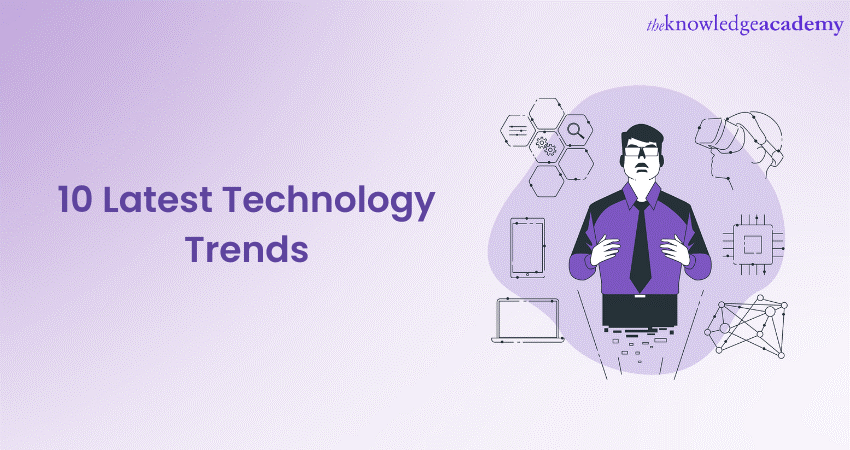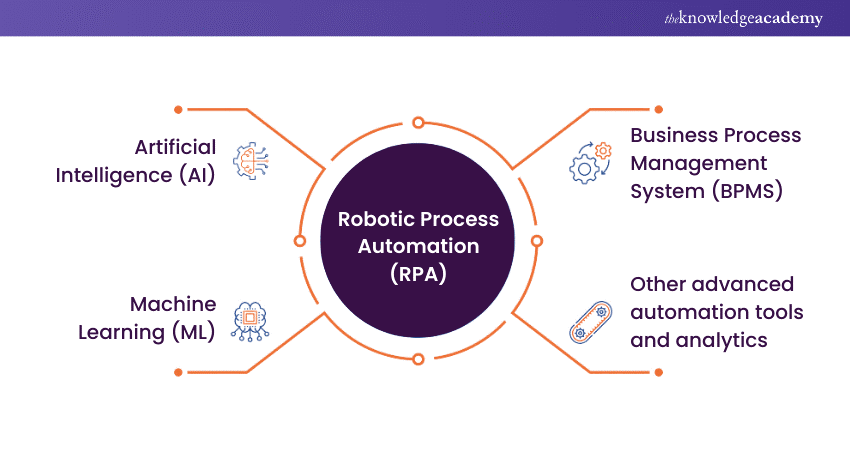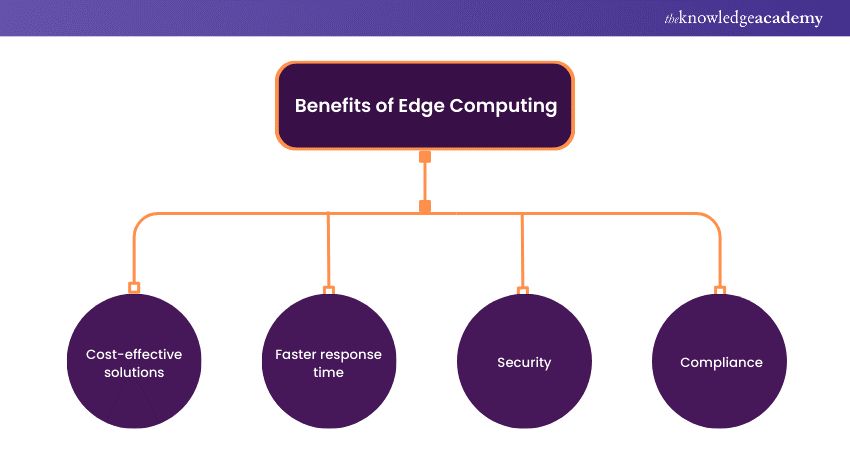We may not have the course you’re looking for. If you enquire or give us a call on +49 8000101090 and speak to our training experts, we may still be able to help with your training requirements.
Training Outcomes Within Your Budget!
We ensure quality, budget-alignment, and timely delivery by our expert instructors.

We have witnessed a multitude of technologies emerging in the market for our day-to-day use. These Latest Technology Trends are pivotal in shaping our future, both personally and professionally. Companies of all sizes — big, small, and medium — routinely train their employees to implement these technological innovations.
According to Statista, the global Information Technology (IT) industry is forecasted to spend approximately £3.80 trillion in 2023 on the latest technologies alone. This level of investment is expected to increase in the future. In this blog, you will learn about some of these Latest Technology Trends and how they are being utilised to enhance the current landscape.
Table of Contents
1) What are the Latest Technology Trends?
a) Quantum Computing
b) Digital Immune System
c) Hyperautomation
d) Datafication
e) Industry Cloud-Platforms
f) Extended Reality
g) Digital Twins
h) Edge Computing
i) Low code/no code development
j) 3D Printing
2) Conclusion
What are the Latest Technology Trends?
The landscape of technology is continually evolving, introducing groundbreaking trends that redefine how we interact with the world. Among the latest trends, Artificial Intelligence (AI) and Machine Learning (ML) stand out, driving innovations in various sectors. The rise of Internet of Things (IoT) devices is transforming everyday objects into smart, interconnected systems.
Blockchain technology is revolutionising data security and financial transactions. Additionally, the advent of 5G networks is set to unleash unprecedented connectivity speeds, facilitating advancements in areas like telemedicine and remote work. These trends, along with advancements in virtual and augmented reality, are not just futuristic concepts but are shaping our present and sculpting the future.
Let’s look into the top 10 Latest Technology Trends:
Quantum Computing
As scientists push the boundaries of technology, Quantum Computing emerges as one of the foremost and latest technology trends. Based on the principles of quantum mechanics, Quantum Computing excels in solving complex problems that are challenging for classical computers. This field also encompasses research in diverse hardware types and application development. Often, quantum computers can solve a broader range of problems more rapidly than their classical counterparts.
Quantum computers outpace classical computers by utilising principles of superposition and entanglement, capabilities beyond the reach of classical computing. This advanced computing can simulate intricate molecules and materials, potentially leading to groundbreaking discoveries in chemistry. Furthermore, Quantum Computing plays a crucial role in developing and refining new algorithms for Machine Learning and Artificial Intelligence (AI). Here are some ways Quantum Computing can be utilised:
a) Discovery of new drugs: Many diseases remain incurable, and scientists continuously seek solutions. Quantum Computing can significantly aid in the discovery of new drugs for these diseases, potentially with fewer side effects.
b) Discovery of new materials: Quantum computers are instrumental in identifying unique materials, particularly beneficial for the aircraft and automotive industries. These industries can leverage Quantum Computing in designing aircraft and vehicle models that are faster, safer, and more economically sustainable.
c) Forecasting weather: Quantum computers have the capability to process and analyse vast amounts of data swiftly, a task challenging for classical computers. They can detect even minor atmospheric changes, aiding researchers and forecasters in developing precise weather predictions. This insight is crucial for preparing for potential droughts, floods, or other natural calamities.
d) Managing financial portfolios: In the stock market, Quantum Computing contributes to making more accurate financial decisions. This technology assists in building and maintaining an organisation's financial portfolio. Quantum processors enable efficient execution of multiple financial transactions.
If you are interested in enhancing your skills in Quantum Computing, then sign up for Quantum Computing Training!
Digital Immune System
The Digital Immune System (DIS) encompasses a range of practices and technologies encompassing software design, development, operation, analytics, and improvement. This system leverages these components to enhance user experience and safeguard various applications and services against anomalies, thereby increasing their resilience to risks and failures. By utilising data analytics, DIS can mitigate business risks and optimise numerous digital operations.
Every organisation should strive to enhance their Digital Immune System. An effective DIS contributes in several ways:
1) Promoting a new perspective that adopts a systematic and scientific approach
2) Enhancing the quality of applications
3) Identifying the right individuals or teams within a company to manage tasks and projects for swift and efficient achievement of targets
4) Integrating Machine Learning algorithms with data from various sources, leading to outputs that are more attuned to user experience and capable of providing real-time results
Upskill yourself with the recent technologies with our Advanced Technologies Courses!
Hyperautomation
Hyperautomation was conceived to help us avoid repetitive tasks. It involves mechanising repeated tasks or business operations, such as marketing processes and workflows, using AI, Machine Learning, and Robotic Process Automation (RPA). Through hyperautomation, these tasks can be significantly automated, employing various types of bots to execute the processes. It benefits organisations by reducing manual labour costs and completing business processes more quickly.

Hyperautomation is also crucial in the context of global digital transformation. Its advantages for the future include:
1) Integration of AI, ML, and RPA into daily operations. These technologies can propel an organisation's growth exponentially by producing results swiftly and minimising errors.
2) Employee engagement and creativity are enhanced with hyperautomation. Freed from mundane tasks, employees can focus on generating innovative solutions and engaging in more stimulating work, thereby maintaining their productivity.
3) Organisations can advance technologically through hyperautomation. It encourages the adoption of technological innovations and equips employees to use them effectively.
4) Beyond handling repetitive tasks, hyperautomation can extract valuable data, aiding in efficient decision-making and problem-solving.
Datafication
We appreciate technologies that can predict our queries and needs, a process known as prediction. However, this prediction is systematised through a process called datafication, a key trend in the latest technological developments. Datafication transforms the behaviours, procedures, and activities of individuals and businesses using AI, ML, Robotics, etc. The generated data can be tracked, assessed, and stored to enhance the services provided by organisations to their customers.
Datafication is a major trend that is bringing about significant changes now and in the future. Here's how:
1) Understanding and analysing data: Organisations can employ datafication to comprehend and analyse data, enabling them to refine their procedures and processes.
2) Assessing company performance: Datafication allows companies to analyse their errors, weaknesses, and strengths. With the use of Big Data, AI, ML, etc., it becomes easier for businesses to invest in this trend.
3) Technology implementation: While organisations are keen to integrate the latest technologies into their daily operations, each technology has specific needs and requirements. Datafication efficiently processes collected data to determine which technology best fits an organisation, analysing business processes to guide technology implementation.
4) Resource and inventory management: Datafication provides estimates of resources and inventories, streamlining business operations. This overview aids in saving time and is cost-efficient.
5) Organising data: Managing vast amounts of data is crucial, and datafication excels in this. It organises the massive amount of collected data, simplifying decision-making and problem-solving for organisations.

Industry Cloud-Platforms
Cloud Computing has gained immense popularity over the last decade, proving beneficial for both large and small-scale organisations. To enhance cloud-based services further, researchers have introduced Industry Cloud-Platforms (ICPs), also known as vertical cloud platforms. These platforms offer cloud-based software solutions tailored to the specific needs of organisations, providing more customised options than general cloud-based platforms.
ICPs offer a broad spectrum of services, ranging from data management to assisting businesses in their operations. This versatility enables organisations to reduce costs and errors while streamlining operations. ICPs can be categorised into three popular types: Software as a Service (SaaS), Platform as a Service (PaaS), and Infrastructure as a Service (IaaS). The benefits of using ICPs include the following:
1) Enhanced security: Customised to each organisation’s specific needs, ICPs offer more defined and relevant security features, maintaining the organisation's security standards without compromising their framework.
2) Improved data management: ICPs facilitate better data access and management. This improvement allows organisations to refine their decision-making, strategy formulation, and problem-solving processes based on their unique data sets.
3) Workflow optimisation: Being specific to an organisation, ICPs simplify focusing on and improving workflows.
4) Cost and time efficiency: ICPs streamline data management, thereby reducing the time and cost associated with business operations.
Extended Reality
Extended Reality (XR) is a fusion of Augmented Reality (AR) and Virtual Reality (VR), blending human interaction with computer-generated graphics to diminish the divide between the real and virtual worlds. This technology is widely used in gaming and sci-fi movies.
Now, let's delve into the two main components of Extended Reality:
1) Augmented Reality (AR): AR involves integrating virtual objects into the real world, even though they are not physically present. A common example is seen in shopping apps that allow users to try on clothes or sunglasses. Similarly, AR can be used to visualise interior decor changes in homes, offering a simulation experience that is entirely computer-generated. AR is effective in reducing costs and time while maintaining high customer satisfaction.
2) Virtual Reality (VR): VR technology immerses users in a 3D environment created by both computer hardware and software. To experience VR, users typically wear goggles or helmets for full immersion. VR creates realistic simulations that various organisations and industries can leverage for business purposes. For instance, in the real estate sector, VR enables realtors to offer virtual tours of properties that are not yet physically constructed, aiding in better understanding and meeting client needs.
Enhance your knowledge of Virtual Reality with Virtual Reality (VR) Training!
Digital Twin
Digital Twin technology represents a significant breakthrough in technological innovation. This technology allows for the creation of digital replicas of physical entities, enabling organisations to simulate real-life scenarios and predict outcomes. For instance, an organisation seeking to enhance a car's speed, horsepower, and safety features can create a digital version using Digital Twin technology to test and refine these attributes.
Different types of Digital Twins share a common trait: they utilise real-time data about the products they represent. A familiar example is Google Maps, which acts as a Digital Twin of Earth by providing real-time traffic data to aid in quicker commuting. This technology offers a wide range of applications to understand, optimise decisions, and foster innovative solutions within an organisation. Additional benefits of Digital Twin technology include:
1) Enhanced product development: Companies traditionally use prototypes for new or improved products. Digital Twin technology streamlines this process, allowing for more efficient analysis and optimisation, thereby reducing both time and costs.
2) Error prevention: With real-time data, potential errors can be identified and addressed before the product’s manufacture and market release.
3) Foundation analysis: As Digital Twins are based on a single source or entity, they are instrumental in tracking the initial build of a product. This capability is crucial for analysing the product's foundation, enabling adjustments or complete redesigns if necessary.
4) Waste reduction: Digital Twin technology significantly reduces material waste. Since processes are conducted virtually, physical resource consumption is minimised.
Interested to know more about Digital Twin? Register now for Digital Twin Training
Edge Computing
Edge Computing is gaining widespread adoption due to its ability to process data at or near the source of its generation. In an era where countless devices are connected via the internet and generate massive amounts of data, Edge Computing plays a crucial role. It handles this vast data influx and reduces latency, ensuring faster and more comprehensive data analysis. This, in turn, helps organisations enhance customer experiences.
Edge Computing proves more efficient than traditional centralised models, which often process data far from its source. By being closer to the data origin, Edge Computing enables more interactive human experiences. It is extensively used in developing self-driving cars, smart speakers, smartwatches, and other technologies. Here are some practical applications of Edge Computing:

1) Security and monitoring: Edge Computing can be applied to onsite cameras and safety devices to monitor environments and improve organisational security. This approach aids in preventing unauthorised access and ensuring adherence to safety policies.
2) Agriculture: In the agricultural sector, Edge Computing assists in determining soil type, temperature, and nutrient levels, significantly aiding agriculturists.
3) Healthcare industry: The healthcare industry benefits greatly from Edge Computing. By analysing data from patients’ wearable medical devices, healthcare professionals can gain better insights into patient health, aiding in the prevention and management of diseases.
Low Code/No Code Development
Low Code/No Code Development (LCNC) is a rapidly emerging trend in technology, greatly reducing coding time and becoming increasingly popular. Built upon actual coding languages, LCNC frameworks accelerate the launch and manufacturing processes with features like drag-and-drop, which expedite the application design process.
LCNC offers a user-friendly experience, allowing quick creation of new applications. It enables even those without formal development training to participate in technological processes, from game development to general tech involvement. LCNC simplifies complex backend issues and streamlines evaluation processes. Here are additional benefits of this technology:
1) Responsive application development: LCNC can be used to develop interactive applications, which helps in reducing delays in supply chains.
2) Accelerated manufacturing: Since many applications are pre-developed, organisations can employ non-developers and train them to use these applications, avoiding the time-consuming process of developing complex codes.
3) Custom business applications: LCNC allows the creation of unique business applications tailored to each organisation, aiding in identifying and improving operational inefficiencies.
4) HR automation: In Human Resources, LCNC can automate various aspects of the hiring process, reducing time spent on employee recruitment. It can automatically filter candidate profiles, refine job descriptions, and expedite the initial stages of hiring.
3D Printing
3D Printing is a process that creates physical objects from digital designs, not by printing on sheets of paper but by layering materials in liquid or powdered form. These layers are successively laid down and fused together to form the final physical object. This technology is particularly advantageous for creating prototypes, especially for parts and devices in manufacturing units.
For small to medium-scale manufacturing, 3D Printing is a cost-effective solution as it reduces both time and expenses. It excels in producing complex designs and shapes with fewer requirements for traditional manufacturing techniques like drilling, moulding, and welding. 3D Printing is not only cost-effective for prototypes but also fosters innovation and experimentation. Here are some additional benefits of 3D Printing:
1) Footwear manufacturing: Renowned shoe brands use 3D Printing to create high-quality, durable shoes.
2) Real estate: In recent years, 3D Printing has been used to construct houses, enabling unique and complex architectural designs.
3) Custom hearing aids: This technology is particularly effective in the manufacturing of custom hearing aids. It allows for precise tuning according to individual ear shapes and the specific materials needed for each hearing aid.
Learn more about 3D Printing with our 3D Printing Training!
Conclusion
In this blog, we have explored various Latest Technology Trends that are revolutionising the way businesses operate. From streamlining operations to accelerating manufacturing processes, these cutting-edge technologies are propelling organisations towards a more technologically advanced future. We discussed the top 10 technology trends and examined their significant impact across different sectors. These innovations not only optimise current practices but also open doors to new possibilities, shaping the landscape of industries and redefining the benchmarks of efficiency and innovation.
Frequently Asked Questions
Upcoming Career Growth Batches & Dates
Date
 5G Wireless Training
5G Wireless Training
Thu 23rd Jan 2025
Thu 20th Mar 2025
Thu 22nd May 2025
Thu 17th Jul 2025
Thu 18th Sep 2025
Thu 20th Nov 2025







 Top Rated Course
Top Rated Course


 If you wish to make any changes to your course, please
If you wish to make any changes to your course, please


